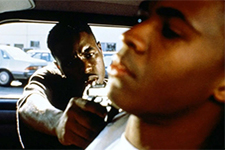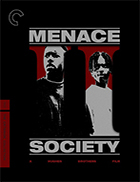Menace II Society (4K UHD)
|  Allen and Albert Hughes’s powerful inner-city drama Menace II Society is, in just about every way, a classical gangster film. Although it is set in the Watts section of Los Angeles in the early 1990s and virtually all of the characters are black, in structure and theme it the clear descendent of the immigrant gangster film, whose roots go as far back as D.W. Griffith’s The Musketeers of Pig Alley (1912) and Raoul Walsh’s Regeneration (1915) and reached its peak in the 1930s with William Wellman’s The Public Enemy (1931) and Howard Hawks’s Scarface (1933). Like Menace II Society, those films were ostensibly violent parables about the social, political, and personal horrors of organized crime, yet their gangster protagonists—tommy gun-toting folk heroes from the ethnic slums—were so appealing in their tragedy and the genre’s dramatic form was so engaging and entertaining that the industry declared an official moratorium on them in the mid-1930s. The gangster film has always been about conflict—not just the conflict between criminals and the social structures against which they are rebelling, but the conflict they engender in the audience, which is asked to both sympathize with the gangster and feel abhorrence toward his actions. This conflict arises from the gangster film’s acute dramatization of the gangster’s victimization by oppressive social forces that create and nurture his criminality by closing off all avenues to traditional success for those who are unlucky enough to be born into the wrong circumstances. Gangster (and gangsta) antiheroes are often orphans or born into abusive families in poverty-stricken neighborhoods, where success means money, loyalty to those close to them trumps respect for social structures (cue N.W.A.’s ’80s social protest anthem “Fuck tha Police”), and violence is the only means to get what one wants. “Might is right” is the law of the street, and although gangsters are usually doomed to failure (and often death), we ride along with them because the film invites us into their perspective. We see firsthand how their life is Horatio Alger’s American dream flipped upside down and twisted into nihilism. Menace II Society’s protagonist is Caine (Tyrin Turner), an 18-year-old recent high school graduate living in Watts who has known nothing his whole life but violence and the street (one of his earliest memories is seeing his father, played by Samuel L. Jackson, shoot a man at his kitchen table during a poker game over money he is owed). Caine narrates the film in a soft voice that often belies what we see on screen, even as it deepens our understanding of the choices he makes (the voice-over narration, in this regard, is essential to the narrative’s mechanics, but it is also setting up the film’s most powerful punch, which it delivers in the final few seconds). As his Biblical name suggests, Caine is a purveyor of violence, although his willingness to murder and steal is tempered by a core of morality that he is constantly fighting. Although he spent his adolescent years with his grandparents, who are deeply religious and fundamentally kindly people, the damage done to Caine early on is all but insurmountable. In the film’s key moment, his grandfather asks him as he walks out the door if he wants to live or die, to which Caine, after a moment of reflection, can only say, “I don’t know.” It is a moment of brutal and disarming honesty that drives home the tragedy of Caine’s life. The number of black lives lost in the film and Caine’s reluctance to fully embrace his own was resonant in the early ’90s and is even more so today in the Black Lives Matter era, which has seen the continuation and perpetuation of the very problems that Menace II Society dramatizes. Caine’s best friend is O-Dog (Larenz Tate), who represents the worst the black ghettos have to offer. Charismatic and nihilistic, O-Dog is described by Caine as white America’s worst nightmare: “Young, black, and doesn’t give a fuck.” In the film’s shocking opening sequence, which has not dulled one bit in the 28 years since the film’s release, O-Dog and Caine enter a Korean grocery to buy some beers, and O-Dog ends up gunning down both the grocer and his wife out of pure spite. They steal the surveillance camera tape of the murder, which becomes a hot commodity in the neighborhood. The tape illustrates a crucial difference between Caine and O-Dog: While O-Dog happily shows the tape to his friends, freeze-framing and laughing with at the exact moment of the murder, Caine is filled with guilt about the needless killing and also realizes the implications of what would happen if the tape ever got out. Thus, like many of his gangster forebears, Caine’s hardened exterior hides a core of sensitivity and decency that is always in danger of being fully snuffed out. Caine’s core of decency is brought out by Ronnie (Jada Pinckett), the ex-girlfriend of Caine’s mentor, who is serving a life sentence, leaving Ronnie with a four-year-old son who was born shortly after he went inside. Ronnie is still intertwined with the goings-on in the ’hood, but she can stand back and see the inherent destructiveness of the actions taken by those around her, including Caine and his friends. Yet, she is also one of the few people who recognizes Caine’s interior, the man he could be if he could be extracted from the life he has always known, and she reaches out to him as best she can. She wants a life better than what she has, and she is willing to leave everything behind for the betterment of her son. She wants Caine to come along with her, to leave his past behind, and his reluctance to leave despite knowing that he should adds to his dramatic complexity and moral dilemma. Allen and Albert Hughes were only 21 years old when they directed Menace II Society, which they also co-wrote with Tyger Williams. That two filmmakers could, at such a relatively young age, produce a work so mature and so confident in its perspective and style is testament to the sheer prowess of their natural filmmaking ability. The Hughes Brothers (as they were credited) had no formal training, no film school degrees; it was years of experience making home videos with their siblings and neighbors that instilled in them the knowledge of how to tell a story on the screen. From the opening moments, they fill the film with visceral images that stay with you long after it is over. They demonstrate a keen eye for nuance and detail, and they show a willingness to deploy an arsenal of stylistic devices: canted camera angles and slow motion, long tracking shots, a mix of ’70s soul and ’90s hip-hop on the soundtrack, and archival news footage to provide historical context to the film’s in-the-moment nightmare. The violence is intense, partially because they heighten its visceral impact with slow motion that brings to mind the best work of Sam Peckinpah, who also sought to overcome the inherent distancing nature of the movie screen by extending the bounds of reality (interestingly, this is an aesthetic choice that they have since come to regret, but I find it alarmingly powerful). Menace II Society was released during a period that saw a flourishing of Hollywood films about black life in America, often made by black filmmakers. Many of these were action-oriented crime films that were the descendants of 1970s Blaxploitation, including Mario Van Peebles’s New Jack City (1991), Ernest R. Dickerson’s Juice (1992), Walter Hill’s Trespass (1992), and Deep Cover (1992), whose director, Bill Duke, came out of acting retirement to play a small, but crucial role as an interrogating police detective in Menace II Society. There were also a number of similarly themed dramas, notably Boyz N the Hood (1991), whose director, John Singleton, was also 21 when he made it (which made him the youngest filmmaker ever nominated for a Best Director Oscar) and would go on to make a number of films chronicling black life in the inner city, including Poetic Justice (1993) and Baby Boy (2001). Like Boyz N the Hood, Menace II Society was predicated on its sense of reality and its willingness to confront difficult truths about its subject (the film’s advertising tagline was “This is the truth. This is what’s real.”). The world of Menace II Society is violent and self-destructive, a point the Hughes Brothers drive home with vivid intensity; whereas Singleton wanted to impart a sense of hope and a message of responsibility within the world of violence depicted in Boyz, the Hughes Brothers seem more intent on simply visualizing the downward spiral of ghetto life unadorned. Theirs is a scathing portrait of the inner-city world in which violence begets more violence, creating a cycle for which there appears to be no end. As Ed Guerrero noted in his 2001 essay “Black Violence as Entertainment,” “With black inner-city neighborhoods ringed and contained by police departments, totally deindustrialized, poisoned with abundant drugs, fortified with malt liquor, and flooded with cheap guns, ghettos have become free fire zones where the most self-destructive impulses are encouraged by every social and economic factor in the environment. Or as a white cop in Spike Lee’s Clockers (1995) coldly analogizes, the urban ghetto has become ‘a self-cleaning oven.’” Menace II Society’s portrait of that “self-cleaning oven” and the victims who live and die in its sits in your gut for a long time, tugging at you heart, making you question the world in which we live and where we’re all going. It is not just a film about the black condition in the ’hood. It is about human choices and fighting against the injustices of the world and accepting help when it is offered. In the end, it is about life and death, and the powerful accumulation of all those choices we make in-between.
Copyright © 2021 James Kendrick Thoughts? E-mail James Kendrick All images copyright © The Criterion Collection | |||||||||||||||||||||||||||||
Overall Rating: 


 (3.5)
(3.5)


